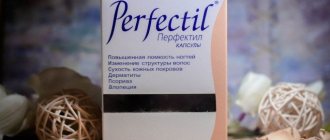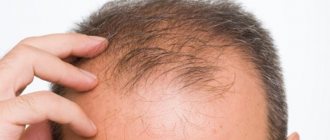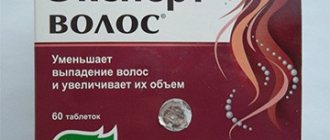Hair is a derivative of the skin and consists primarily of keratin. The hair itself consists of a visible part - the shaft - and a hair follicle, which is immersed in the dermis to a depth of 3-4 mm and has access to feeding capillaries. The density, color and thickness of hair depends partly on heredity, but hair type, rate of growth and loss are influenced by various factors.
Hair loss is a natural process, but if you notice increased hair loss with follicles, this may indicate pathological changes occurring in the body. In this case, you need to contact a trichologist so that he can determine the causes of hair loss and select effective ways to combat it.
Causes of hair loss
Among the main causes of hair loss, trichologists name:
- stress and increased mental, physical or emotional stress. Stress can also arise due to moving to a different climate zone;
- avitaminosis. For normal hair growth and development, iron, B vitamins, retinol, and selenium are required. If there is a deficiency of these microelements in the diet, hair loses its shine and strength, falls out and grows worse;
- hormonal disbalance. Often causes hair loss during puberty (13-17 years), during pregnancy, menopause;
- uncontrolled medication use. Some drugs can inhibit hair growth and cause increased hair loss. For example, a course of chemotherapy, heparin-based medications, and antidepressants lead to diffuse alopecia;
- skin diseases. Fungi, bacteria and viruses that attack the skin often affect the hair follicles. If you do not consult a trichologist or dermatologist in time, dermatosis can cause partial or complete baldness.
Depending on the cause, doctors distinguish several types of hair loss:
- androgenetic alopecia. In 95% of cases it is the main cause of baldness among men, and half as often among women. The main factor that provokes hair loss is androgens, hormones that change the structure of the hair follicle and the surrounding pouch. Hair not only falls out, but also becomes thinner and then stops growing;
- diffuse. The second most common after androgenetic, it is diagnosed more often in women than in men. With this form of baldness, the cycle of hair growth and rest is disrupted: that is, the follicles prematurely go into the resting phase, hair falls out, but new ones are not formed. Diffuse baldness can be triggered by severe stress, hormonal imbalance, or the complex effect of some medication on the body (for example, during chemotherapy);
- focal. It is observed not throughout the entire scalp, but in a separate area of the skin. As a rule, it develops due to damage to the hair roots due to an autoimmune reaction, for example, after an infectious disease or an administered vaccine;
- cicatricial. Occurs when the skin is replaced by scar connective tissue. The cause is usually a skin infection or injury.
The condition of the hair can be affected by the cosmetics used, regular hot styling, and exposure to cold on the scalp.
Myths about baldness
There are many legends and myths about hair loss, causes and treatment. Let's look at the most popular of them:
- Perms and dyeing are very harmful. These procedures can affect the structure of the hair, making it brittle and brittle. However, this spoils the appearance of the hairstyle, while the roots remain intact.
- Hair loss is exacerbated by wearing hats and wigs. This statement is only true if the hats fit too tightly to the head and interfere with blood flow.
- Frequent scratching causes more hair to be lost. This is not entirely true. If you use combs made from natural materials and do not use them too intensively, then you will not be at risk of baldness.
- Some hairstyles contribute to hair loss. This statement applies mainly to ponytails and African braids. Indeed, constantly wearing such hairstyles can thin out your hair. However, this is a temporary phenomenon, and over time the density of the curls will be restored.
- Do not dry your hair with a hairdryer. Abuse of mechanical means and non-compliance with temperature conditions make hair dry and brittle. They break and remain on the comb in large quantities, but this action does not affect their growth or number.
- Baldness cannot be stopped. This is wrong, it all depends on the cause of hair loss.
Many girls ask the question: “How to help yourself without harming or aggravating the problem?” Use our tips - and they, in combination with other methods, will give amazing results.
Hair loss after childbirth
Many women experience hair loss during pregnancy and after childbirth. Typically, increased hair loss begins 1-4 weeks after the baby is born. This is caused by a number of factors:
- changes in hormonal levels;
- stress;
- the production of breast milk, which uses a large amount of nutrients;
- loss of blood during childbirth.
Increased loss stops within a year after the birth of the child. But sometimes the thickness and beauty of hair is not restored. To prevent this from happening, you should contact a trichologist who will select vitamin complexes to eliminate vitamin deficiency.
Finasteride tablets
Finasteride tablets have been developed only for men whose hormonal system has a number of peculiarities. They drink them for several months. If the patient has already lost most of the hair on his head, the most effective combination is minoxidil for daily rubbing and oral finasteride.
In general, international standards have been developed for the treatment of skin, scalp and hair problems, which are used as the basis for choosing tactics.
The editors thank the BioMi Vita clinic for their assistance in preparing the material.
Baldness from stress
One of the common causes of diffuse alopecia is stress. This is the name given to the body’s reaction to the effects of various negative stress factors: for example, increased mental or physical stress. Excessive excitement and anxiety cause a response from the central and peripheral nervous system. For example, capillaries narrow, tissue nutrition deteriorates, the hair follicle receives less nutrients, and hair falls out.
Another effect of stress on the condition of hair is that it leads to a change in the cycles of growth and rest: the follicles enter the resting phase and the hair shaft falls out.
Prevention of baldness in women
- The main tip for maintaining luxurious hair is taking care of your health. You should not get carried away with diets that lead to serious problems in the body. External beauty, including hair, depends on the condition of internal organs. They should receive full vitamins (especially group B), microelements and other necessary substances.
- It is worth limiting the use of hot products for styling curls and chemical dyeing.
- When choosing shampoo, conditioner, masks and other hair care products, you should listen to the advice of experts, because a mistake leads to baldness.
- For preventive purposes, it is useful to use herbal decoctions for rinsing: burdock, hops, chamomile, nettle.
Quitting alcohol and smoking will help improve your health, and with it the strength of your hair. You can’t overcool your head in winter by giving up a hat.
What vitamins are missing if your hair falls out?
Hair loss is caused not only by a lack of iron, but also by other micro- and macroelements:
- zinc deficiency. Participates in metabolic processes and the production of skin cells. If there is a lack of it, not only the hair suffers, but also the nails (they become brittle), the nail fold can become inflamed;
- vitamin D deficiency. Causes structural changes in the structure of the skin, and also inhibits the growth and development of hair follicles. As a result, hair grows much worse.
Lack of protein and fat in the diet can also lead to hair loss. Professional athletes who adhere to a strict diet face a similar phenomenon.
Onion mask
Of course, not all beauties will like the strong onion spirit. But what to do? Serious problems require serious solutions. To prepare the mask, we need one large onion and one tablespoon of vegetable oil. It is better to use olive oil, but if you don’t have it on hand, then any will do. Grate the onion and mix with oil - the mixture is ready. Rub it into the scalp with massage movements and leave for 20 minutes. As always, you should put a plastic cap on your head and cover your hair with a towel.
The procedure should be repeated every three days for six months. As a result, intense hair loss will stop, and dormant hair follicles will be activated.
Why does hair fall out a lot in spring?
In the spring, many people experience increased hair loss, which develops for several reasons:
- avitaminosis. During the winter, the nutrients accumulated by the body run out, which leads to a lack of vitamins;
- temperature fluctuations. Cold has a negative effect on hair thickness: capillaries narrow, hair receives less nutrients and begins to fall out;
- stress and hormonal fluctuations. In spring, people are susceptible to hormonal changes, which can also negatively affect the condition of their hair.
Hair falls out a lot when washing your hair
The life cycle of hair is divided into three stages: anagen (growth), catagen (rest) and telogen (loss). On the human head, hair is simultaneously present in all three phases of its cycle. Hair that is in the process of falling out easily reacts to any external influence (for example, combing or washing your hair) and falls out.
Trichologists have calculated that the normal rate of hair loss is about 100 per day. About 10,000 hairs on the head are simultaneously in the stage of growth arrest (telogen) and can fall out when combing or washing the hair. If you experience discomfort when washing (burning sensation, itching), this may be an allergic reaction to the cosmetic product. You need to change your shampoo and see a trichologist.
"Miracle" remedies from the pharmacy
As a rule, “magic” shampoos and conditioners that promise to cure everything in the world are not worth the money they ask for. Do not trust advertising - first ask a specialist, find information on the Internet or chat with fellow sufferers on forums. Be extremely careful - some components may be hazardous to your health!
All home remedies can only stop severe hair loss in one case - the reasons must be accurately determined by a doctor. If the doctor has not ruled out a serious illness, then cosmetic procedures are unlikely to help. If hair continues to fall out, a specialist may recommend transplantation or weaving nylon threads into your own hair. It is up to you to decide whether to agree to these expensive procedures or not. But, as you know, a woman is capable of much and nothing can stop her on the path to beauty.
What to do if your hair falls out?
If you notice that you are losing more hair every day than before, make an appointment with your doctor. The trichologist will perform digital trichoscopy - a diagnostic procedure that allows you to determine the viability of the follicles, the thickness of the hair shaft, and the concentration of hair follicles per square centimeter of skin. Based on the results, the doctor will make a diagnosis and, if necessary, refer the patient for additional studies to identify its cause.
You should also contact a trichologist if you notice:
- dandruff and itchy scalp;
- split ends;
- deterioration in the general condition of the hair (lost shine, looks dull, becomes brittle).
Diagnosis of the disease
The primary diagnosis of alopecia is carried out by a dermatologist.
It detects the presence of skin diseases, infections, and, if necessary, takes samples of the upper layer of skin.
If no obvious diseases are detected, the patient is referred to a trichologist.
He is the one who treats alopecia, determines its stage, as well as the type of baldness.
The basis of diagnosis for a trichologist is identifying the roots, as well as finding out the approximate daily amount of hair falling out . He also necessarily prescribes tests to determine hormone levels (by donating blood from a vein). He also compiles the so-called genetic picture of the patient.
Is it possible to cure hereditary baldness?
Hereditary or androgenetic hair loss occurs in 5-7% of people and is caused by genetic factors. Hair follicles are affected by androgens (sex hormones present in both men and women). They block the formation of new follicles and have a depressing effect on the hair follicles. As a result, hair becomes thin, stops growing or falls out.
Properly selected therapy can cope with hereditary baldness. The main thing is to start treatment as early as possible. This will allow you to maintain the thickness and uniform renewal of your hair.
Hair loss - treatment at home
Often, hair loss is caused not by external, but by internal reasons - for example, hormonal imbalance or lack of nutrients. It is impossible to independently determine the cause of baldness. To do this, you need to contact a trichologist, who will refer you for the necessary research:
- general blood analysis;
- blood test for hormones;
- digital trichoscopy.
Based on the results, the trichologist will determine the type of alopecia and develop effective treatment. As for “traditional medicine” remedies, they can only slightly improve the condition of the hair. For example, masks made from natural ingredients are very popular: honey, cinnamon, nettle infusion, and so on. They work by nourishing the surface layer of the skin and warming it up. As a result, the blood supply to the hair follicles improves and they become stronger.
Masks cannot be used if the cause of baldness is seborrheic dermatitis, a skin infection. In this case, the procedure will only cause additional inflammation of the skin and worsen the infection or fungal infection. For effective and efficient treatment, consultation with a specialist is necessary.
What to do and treatment
Before prescribing a course of treatment, it is necessary to undergo a thorough diagnosis of the disease. This will allow you to identify the exact cause of the problem and begin to eliminate it. A comprehensive examination includes:
- blood chemistry;
- trichogramma;
- hair analysis;
- blood analysis.
Haircuts for thin hair without styling: simple and beautiful options
Read more about shades of Londa hair dyes here
Types and methods of creating a men's mohawk hairstyle: https://guruhair.ru/muzhskie/strijky/kreativnye/stilnye-muzhskie-pricheski-s-ispolzovaniem-irokeza.html
Treatment of the causes that caused the onset of baldness will allow the hair to begin to recover on its own. If, however, the case requires radical intervention, the following may be prescribed:
- drugs for oral administration;
- head massage;
- homeopathy;
- means for external local use;
- medical masks and shampoos against hair loss;
- laser therapy;
- strengthening homemade hair masks.
All methods are aimed at stopping hair loss and stimulating new hair growth.
To achieve a positive and lasting result, complex treatment is used. To prevent the recurrence of the problem, women need to adhere to a healthy lifestyle, a balanced diet and monitor the hygiene of their strands.
How to stop hair loss?
To stop hair loss, you need to identify its cause. If it is caused by a hormonal imbalance, medications are prescribed to compensate for the lack or excess of hormones. Vitamin complexes are also prescribed to eliminate the deficiency of iron, zinc, vitamins A and B. Doctors often prescribe physiotherapy, including:
- using a Hairmax laser comb. The device affects the hair follicles and scalp with low-intensity laser radiation. It does not cause any discomfort, but at the same time stimulates blood flow to the roots. Regular use of a laser comb improves the condition of the hair shaft (it becomes thicker and shiny), accelerates hair growth, and prevents baldness. The duration and intensity of the course is determined by the trichologist;
- mesotherapy. Involves the injection of drugs into the deep layers of the skin. The complex of vitamins and medications is selected individually, depending on the individual characteristics of the patient’s body. Mesotherapy allows you to nourish the deep layers of the dermis, which has a positive effect on the condition of the hair.
If you notice that there is more hair left on your comb than before, this is an alarming sign and a reason to make an appointment with a trichologist. The doctor can also select other procedures aimed at strengthening hair follicles and active hair growth.
“Excesses” or increased oiliness of the scalp, dandruff.
If your sebum production is too high, then in the absence of treatment, the mouths of the hair follicles become clogged with desquamated skin flakes. Hair nutrition and metabolic processes are disrupted, and the scalp becomes inflamed. All this leads to gradual thinning of hair and cessation of its growth. This is clearly visible during video diagnostics. When examined with the naked eye, the scalp may look clean, but with high magnification, the doctor can immediately see clogged follicles and inflamed hair roots.
What will the doctor prescribe?
The first and most important thing is to clean the mouths of the follicles. It is better if these are professional peelings for the scalp, carried out by a specialist, however, there are effective kits for home treatment (from Optima, Simone, etc.). A trichologist will help you choose the right one. The course consists of 7–14 procedures.
At the same time, it is necessary to reduce the activity of scalp bacteria. This is achieved by regular use of home remedies containing piroctone olamine, climbazole, tea tree, tar, zinc, etc. It is more effective when the product combines several of the above-mentioned active substances in high concentration. Typically, these are professional products sold in clinics on the recommendation of a doctor.
The activity of the sebaceous glands can be normalized with homeopathic mesotherapy carried out in the clinic; the course consists of 7–14 procedures; there are practically no products with comparable effectiveness in home care.










